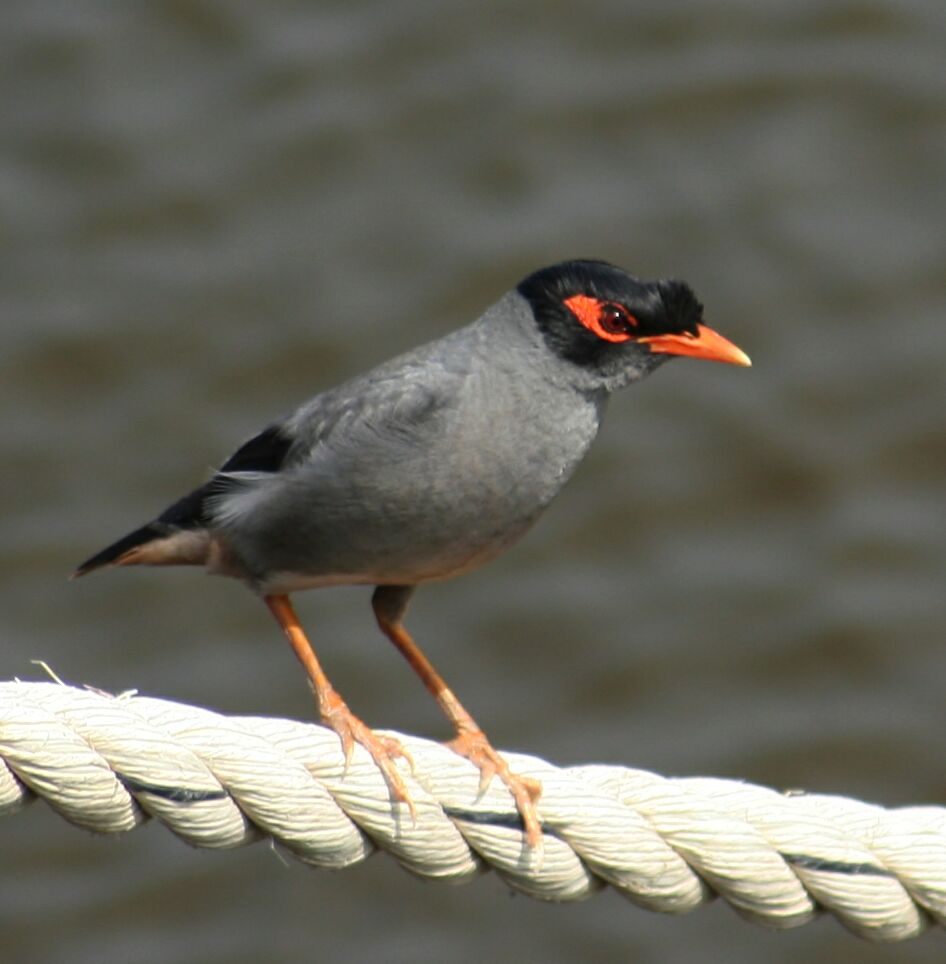- Bank Myna
Taxobox
name = Bank Myna
status = LC | status_system = IUCN3.1
status_ref = [IUCN2006|assessors=BirdLife International|year=2004|id=51916|title=Acridotheres ginginianus|downloaded=2007-04-21 Evaluations (history: 1988 / 1994 / 2000, all LC). There is evidence of a population increase (Feare et al. 1998). ]

image_caption = A "Bank Myna" besides theGanga atBithur
regnum =Animal ia
phylum = Chordata
classis = Aves
ordo =Passeriformes
familia =Sturnidae
genus = "Acridotheres "
species = "A. ginginianus"
binomial = "Acridotheres ginginianus"
binomial_authority = (Latham, 1790)Bank Myna ("Acridotheres ginginianus") is a
Myna /Starling occurring inSouth Asia fromSind ,Pakistan toBangladesh . It is similar in colouration and shares its range with theCommon Myna , but is slightly smaller.Distribution
Sind ,Pakistan , on the West, covering the greater part of northernIndia , east toBangladesh , south to approximate latitutdes ofMumbai ,Maharashtra (19N) /Balasore ,Orissa (21N), except for drier regions inRajasthan . Distribution is patchy, but most commonly in major river valleys. Mostly resident but with regular seasonal local movements in some areas. Individual stragglers documented fromKandahar ,Afghanistan , andChennai ,India , the latter may have been an escaped cage birdcite book
last = Ali
first = Salim
authorlink=Salim Ali (ornithologist)
coauthors =Sidney Dillon Ripley
title = Handbook of the Birds of India and Pakistan, 2nd ed.,10 vols
year = 1986/2001
publisher=Oxford University Press
address = New DelhiBird number 1008, vol. 5, p.181-183.] .Local Names: Ganga myna (Hindi); Gang salik (Bengali); Barad myna (Bihar, mirshikars); Bardi myna (Nepal); Lali (Sind); Daryla myna (Uttar Pradesh).
Habitat: Rocks, in open country and around human habitations, often near tea stalls, markets, etc. Railway stations are particularly favoured. Often in riverside habitats (the Hindi and Bengali names refer to this aspect).
Description
A stocky, bluish-grey
myna h with a deep orange bill and eye patches. Noticeably smaller and greyer than theCommon Mynah . Other differences include
* colouration: pale bluish grey instead of brown, also the black crown has a sharp boundary as opposed to a gradation,
* naked skin round eyes brick-red instead of yellow,
* wing-patch and tips of tail-feathers pinkish buff instead of white.Sexes are alike. Juveniles are paler and browner [cite book
title = Photographic guide to birds of India
last = Grewal
first = Bikram
coauthors = Bill Harvey and Otto Pfister
publisher = Periplus editions
address = Hong Kong
year = 2002] .Gregarious, often in flocks even during breeding season. Usually very tame and confiding, often seen on railway stations, sauntering confidingly along platforms, in and out of the feet and baggage of passengers, picking up bits of food. Haunts municipal refuse dumps for scraps and tidbits and attends on grazing cattle for insects. Also seen in markets (e.g.
Old Delhi ), surreptitiously hopping onto vendors' handcarts to steal scraps. Often following herds of cattle.Voice somewhat softer than that of
Common Myna cite book
last = Ali
first = Salim
authorlink=Salim Ali (ornithologist)
coauthors = J C Daniel
title = The book of Indian Birds, Twelfth Centenary edition
year = 1983
publisher=Bombay Natural History Society /Oxford University Press
address = New Delhi] .Food
Fruit, grain, and insects. Can be very destructive to ripending crops of
Sorghum (jowar). An important additional insect pest, recorded among stomach contents inBihar , is larvae of the mothOphiusa melicerte , highly injurious tocastor .Nesting
* Season: May to August, principally April to June.
* Nest: Pad of grass and rubbish, often including bits of snake slough, stuffed in the widened chamber at the end of a horizontal earth tunnels drilled in steep earth banks of rivers, sides of disused brick kilns, earthen wells, as well as other holes in masonry. Often breeds in colonies of fifty or more pairs, along with theCommon Myna .
* Eggs: 3 to 5, glossy pale blue.Gallery
References
Wikimedia Foundation. 2010.
